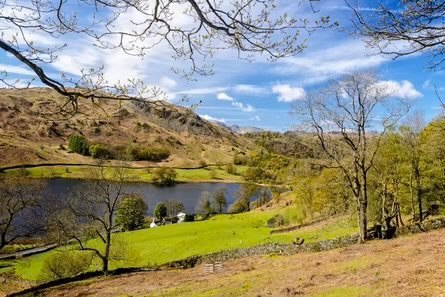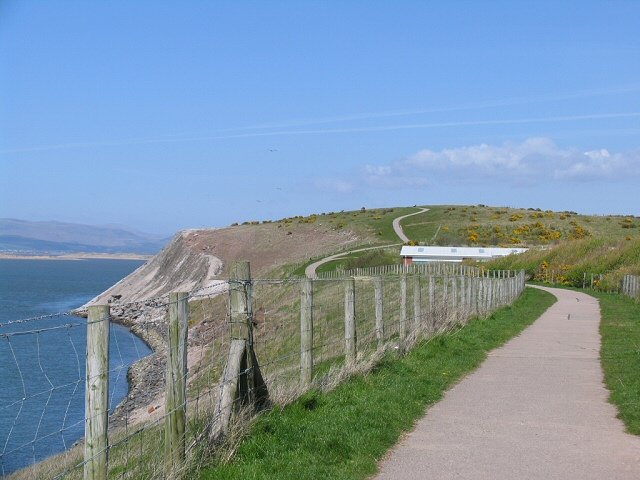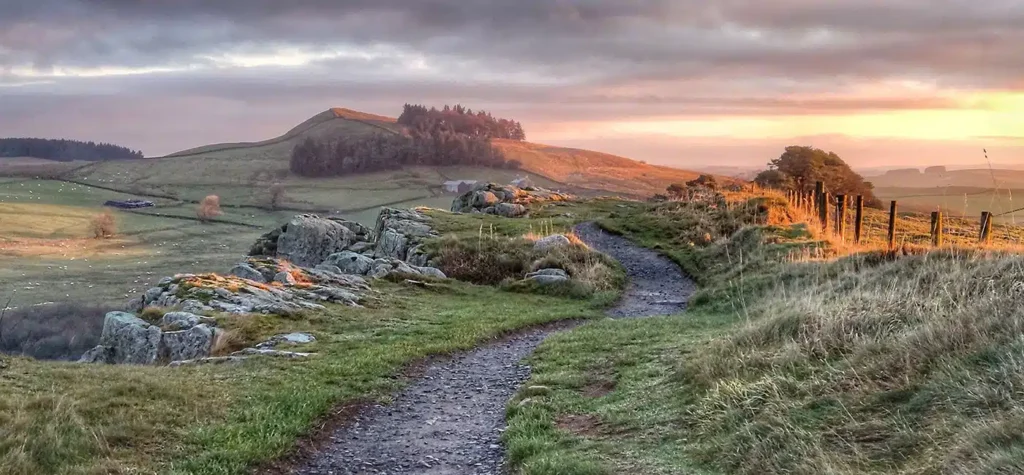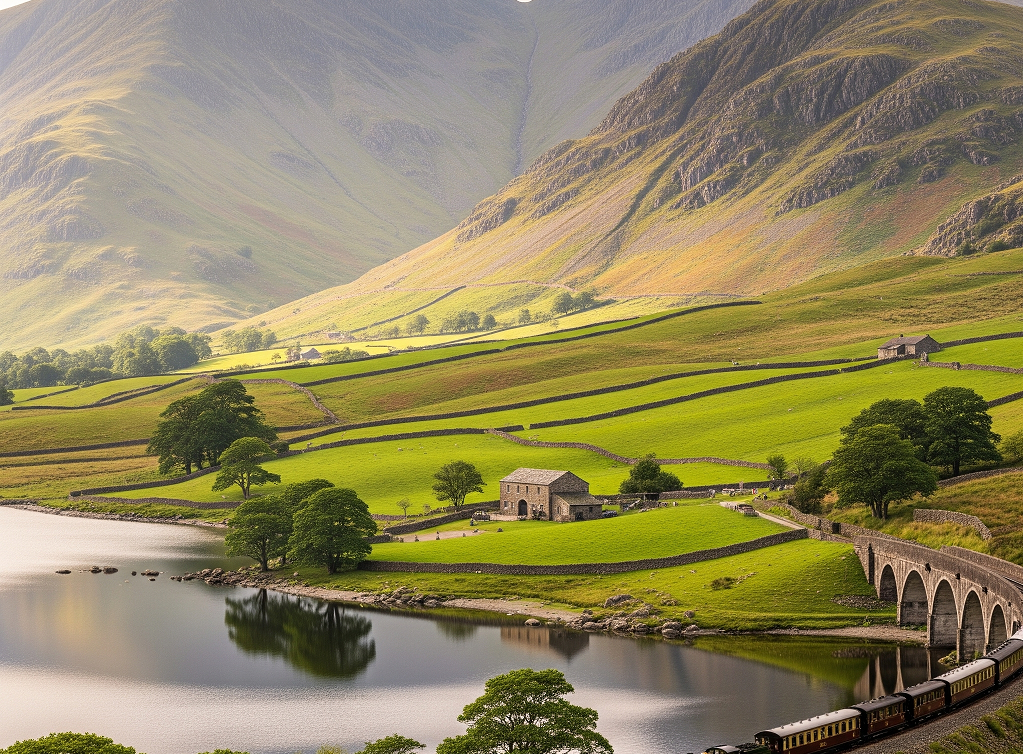
Key Takeaways
- Discover Cumbria beyond the usual lakes and hikes.
- Try unique experiences like alpaca treks, hot air balloon rides, and ghost tours.
- Activities are deeply connected to the landscape, fells, forests, valleys, and coastline.
- Explore history, art, and adventure in unexpected places like hidden art barns and steam trains.
- Perfect for curious travellers looking for offbeat, geography-rich experiences.
Introduction to Unusual Things to Do in Cumbria
Cumbria, a county often synonymous with the majestic beauty of the Lake District, conjures images of serene lakes and invigorating mountain walks. Indeed, its well-trodden paths and iconic vistas draw millions seeking solace in nature’s grandeur. However, to truly experience Cumbria is to scratch beneath this picturesque surface and delve into a world of quirky and unconventional experiences, woven intimately into the region’s unique geography and rich history.
This guide aims to be your compass to these lesser-known treasures, moving beyond the popular tourist trails to uncover the hidden gems that offer a fresh and often surprising perspective on Cumbria’s diverse landscape and its captivating stories. From subterranean adventures in disused mines to encounters with peculiar local traditions, and from artistic installations nestled in unexpected corners to culinary delights with a distinctive Cumbrian twist, we invite you to explore the county through a different lens. Prepare to discover activities that challenge expectations, spark curiosity, and ultimately, reveal the multifaceted character of this remarkable corner of England.
Discover the Submerged Village of Mardale Green
Nestled within the breathtaking expanse of the Lake District National Park, Mardale Green is a poignant reminder of a community sacrificed for progress. Since the 1930s, this once-thriving hamlet has lain submerged beneath the waters of Haweswater Reservoir, a vital water source for Manchester and the wider North West. Yet, for those who know its secret, Mardale Green offers a unique and haunting glimpse into Cumbria’s past.
During periods of prolonged dry weather, when the reservoir’s water levels recede significantly, a ghostly landscape begins to emerge from the depths. Stone ruins of former homes, the faint outlines of winding lanes that once led through the valley, and even the eerie footprint of the village church, dismantled stone by stone before the flooding, become visible. These ephemeral remnants stand as silent witnesses to a community uprooted and a landscape forever altered.
The story of Mardale Green is one of both remarkable engineering and profound loss. In the 1920s, with a growing demand for water in urban centres, the decision was made to expand Haweswater, transforming the natural lake into a vast reservoir. This required the controversial demolition of Mardale Green, forcing its residents to relocate and their homes, including the beloved Dun Bull Inn and the small village church, to be dismantled or blown up. Even the village graveyard saw its inhabitants exhumed and reburied elsewhere.
Set against a dramatic backdrop of fells and waterways carved by ancient glaciers, the appearance of Mardale Green’s ruins creates a striking intersection of Cumbria’s human and natural history. It’s a place that invites contemplation on the sacrifices made for modern necessities, the resilience of communities, and the enduring power of nature to both shape and reclaim landscapes. Visitors to this extraordinary site are offered a rare and moving opportunity to connect with a lost world, imagining the life that once thrived in this now-submerged valley.
You can learn more about the fascinating history of this area by watching the video embedded below.
Mardale Green The Jewel in a Lost Crown
Try Axe Throwing at Graythwaite Estate
Venture to the southern fringe of the idyllic Lake District, and you might be surprised to discover an exhilarating activity amidst the tranquil beauty: axe throwing at Graythwaite Estate. Far from the typical ancient sport, this experience offers a unique blend of adrenaline and camaraderie, set against the stunning backdrop of the estate’s sprawling wooded hills and lush parkland.
Graythwaite Estate, with its gently rolling topography and venerable ancient geology, provides an unexpectedly perfect setting for this primal yet precise activity. The mature woodlands and picturesque vistas, framed by the very landforms shaped over millennia, amplify the sense of both adventure and profound connection to the natural environment. As you hurl a well-balanced axe towards a wooden target, the satisfying thud of a direct hit resonates not just with personal achievement but also with the echoes of historical skills and traditions.
The estate itself is steeped in cultural tradition, having been in the same family for centuries, adding a layer of historical depth to your experience. This rich heritage infuses the modern thrill of axe throwing with a unique sense of place. Whether you’re a seasoned pro or a complete novice, expert instructors are on hand to guide you through the techniques, ensuring a safe and thoroughly enjoyable session. It’s an opportunity to engage in a surprisingly meditative and empowering activity, where focus and precision are key, all while breathing in the fresh Cumbrian air and soaking in the serene beauty of the surroundings.
Axe throwing at Graythwaite Estate isn’t just about hitting a target; it’s about embracing an unusual challenge in an extraordinary location, creating lasting memories against a backdrop that perfectly blends natural grandeur with a touch of rugged adventure. It’s an ideal outing for friends, families, or corporate groups looking for an activity that is both engaging and uniquely Cumbrian.
Walk with Alpacas or Llamas through the Fells
For those seeking a truly unique and tranquil way to immerse themselves in Cumbria’s magnificent landscape, consider embarking on a guided walk with alpacas or llamas. Available in the picturesque Eden Valley or on the scenic fringes of the Lake District, these gentle, inquisitive creatures offer a novel and enchanting companionship as you traverse the region’s iconic uplands.
The fells, Cumbria’s defining geological feature, are broad, sweeping expanses of upland pasture and moorland, their distinctive, rounded forms sculpted over millennia by the relentless power of glaciers. Crowned by majestic peaks such as the imposing Helvellyn and the mighty Skiddaw, these ancient landscapes become even more captivating when experienced alongside the unhurried pace and amiable presence of an alpaca or llama. Their calm demeanour and natural curiosity encourage a slower, more mindful appreciation of the surroundings, transforming a simple hike into a truly memorable encounter.
As you embark on these unique treks, your sure-footed companions will lead you along ancient pathways, past weathered dry-stone walls that crisscross the landscape like intricate stitches, through pockets of old woodlands where dappled sunlight filters through the canopy, and across vast stretches of open pasture dotted with grazing sheep. This delightful blend of South American charm with the distinctively rugged yet serene Cumbrian scenery creates a truly harmonious experience.
Beyond the sheer novelty, walking with alpacas or llamas offers a profoundly relaxing and therapeutic experience. Their gentle hums and placid nature have a calming effect, making these walks accessible and enjoyable for all ages and abilities. It’s an opportunity to connect with nature on a deeper level, to learn about these fascinating animals, and to discover hidden corners of Cumbria that might otherwise remain unseen, all while creating cherished memories with these charming, woolly companions.
Find Tranquillity at a Buddhist Temple Retreat
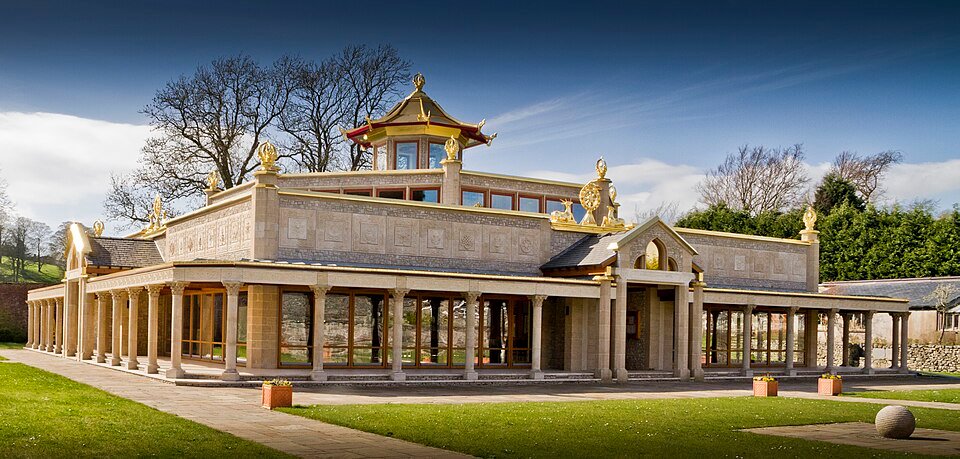
Escape the everyday and discover a profound sense of peace at the Manjushri Kadampa Meditation Centre, nestled in the serene landscapes of South Cumbria. Situated near the tranquil shores of Morecambe Bay, this spiritual sanctuary is housed within a grand Victorian mansion, offering a striking blend of architectural elegance and a deeply calming atmosphere.
The true magic of Manjushri Centre lies not only within its walls but also in its extraordinary surroundings. The centre is enveloped by expansive parkland, ancient woodlands, and the gentle contours of soft coastal hills, creating an environment perfectly conducive to contemplation and inner peace. Here, the very landscape itself deepens the spiritual experience. Imagine meditating in rooms that offer sweeping views of the tidal estuaries, where the rhythmic ebb and flow of the water mirrors the natural cycles of breath and thought. Meander along tranquil trails that thread through mossy woods, where sunlight filters through ancient canopies, inviting quiet reflection.
The centre’s unique location is a key element in its profound sense of serenity. Positioned at the natural intersection of Morecambe Bay, the meandering River Leven, and the gentle upland hills, it offers a distinct sense of remoteness and calm, a world away from the more bustling tourist hubs of the central Lake District. This harmonious blend of coastal vistas, riverine tranquillity, and gentle pastoral scenery provides an ideal backdrop for mindfulness and spiritual growth.
Whether you are an experienced meditator or simply seeking a peaceful respite from the demands of modern life, Manjushri Kadampa Meditation Centre offers a range of retreats, courses, and drop-in classes. It’s an opportunity to learn ancient wisdom, practice meditation, and simply be present in a truly beautiful and reflective setting. The quiet beauty of the Cumbrian coastline, combined with the profound teachings offered at the centre, creates an experience that nurtures the soul and encourages a deep sense of inner calm.
Go Ghost Hunting at Haunted Muncaster Castle
Perched majestically above the enchanting Esk Valley, near the charming coastal village of Ravenglass, stands Muncaster Castle, a formidable and awe-inspiring edifice that has witnessed centuries of history unfold. Its commanding position allows it to survey both lush, ancient forests and the rugged beauty of the Cumbrian coastline, creating an inherently atmospheric setting that perfectly lends itself to tales of the supernatural and haunted legends.
Situated tantalisingly close to the western edge of the Lake District National Park and dramatically backed by the imposing peaks of the Scafell Range, the castle’s location is as captivating as its history. This unique geographical blend of mountainous grandeur and coastal mystique contributes significantly to its enduring reputation as one of Britain’s most haunted castles.
Within its ancient walls, Muncaster Castle is steeped in a rich and often chilling tapestry of folklore. The castle’s storied Tapestry Room is particularly renowned for its paranormal activity, with numerous accounts of spectral encounters and unexplained phenomena. Visitors often report feeling a sudden chill, hearing disembodied whispers, or witnessing objects move on their own.
For those brave enough to delve deeper into its ghostly past, Muncaster Castle offers captivating evening ghost tours. These immersive experiences take visitors on a journey through the castle’s dimly lit chambers and shadowy corridors, bringing to life the chilling tales of resident spectres such as Tom Fool, the notoriously mischievous jester, and the White Lady, whose mournful presence is said to linger in the grounds.
These ghost tours are more than just a spooky experience; they are a fascinating exploration of how Cumbria’s moody geography and layered folklore intertwine. The dramatic scenery outside seems to echo the dark and intriguing narratives within the castle, creating a truly unforgettable experience that chills and thrills in equal measure. Whether you’re a devout believer in the supernatural or simply a curious explorer, a visit to haunted Muncaster Castle promises a unique and spine-tingling encounter with Cumbria’s deeper, darker history.
Visit the Merzbarn: Dada Art in Elterwater
Nestled within the breathtaking and dramatic confines of the Langdale Valley, a landscape dominated by towering crags and ancient woodlands, lies an unexpected treasure: the Merzbarn. This unassuming structure holds a significant place in the history of 20th-century avant-garde art, being the final, unfinished masterpiece of the renowned German Dada artist, Kurt Schwitters.
Schwitters, a refugee from Nazi Germany, found both profound inspiration and essential seclusion in this remote corner of Cumbria. The raw, untamed beauty of the Lake District, with its majestic fells and serene valleys, offered him a haven where he could continue his revolutionary “Merz” art — a unique form of collage and assemblage that sought to integrate everyday objects and fragments into unified artworks. The Merzbarn was intended to be a complete environment, a walk-through sculpture evolving over time, reflecting his artistic philosophy.
A visit to the barn offers a truly unique cultural experience, seamlessly pairing radical avant-garde art with the wild, untamed beauty of one of Cumbria’s boldest and most iconic valleys. To stand within the very space where Schwitters meticulously arranged his found objects, contemplating the interplay of textures, colours, and forms, is to gain a direct insight into his creative genius. The barn itself, though now largely preserved and managed by the Hatton Gallery, still resonates with the artist’s spirit.
The surrounding countryside further enhances the visit. This is a landscape profoundly shaped by the immense forces of ancient glaciers, evident in the U-shaped valleys and the imposing, sculpted fells. It’s also a region rich in human history, with traces of Norse settlers discernible in place names and local traditions. Thus, a journey to the Merzbarn becomes a multi-layered exploration: a pilgrimage for art enthusiasts, a discovery for history buffs, and an immersive experience for anyone seeking to connect with the wild beauty and quiet inspiration of the Lake District. It’s a testament to how even in the most remote settings, profound artistic innovation can flourish.
Be Inspired at the Quirky Keswick Pencil Museum
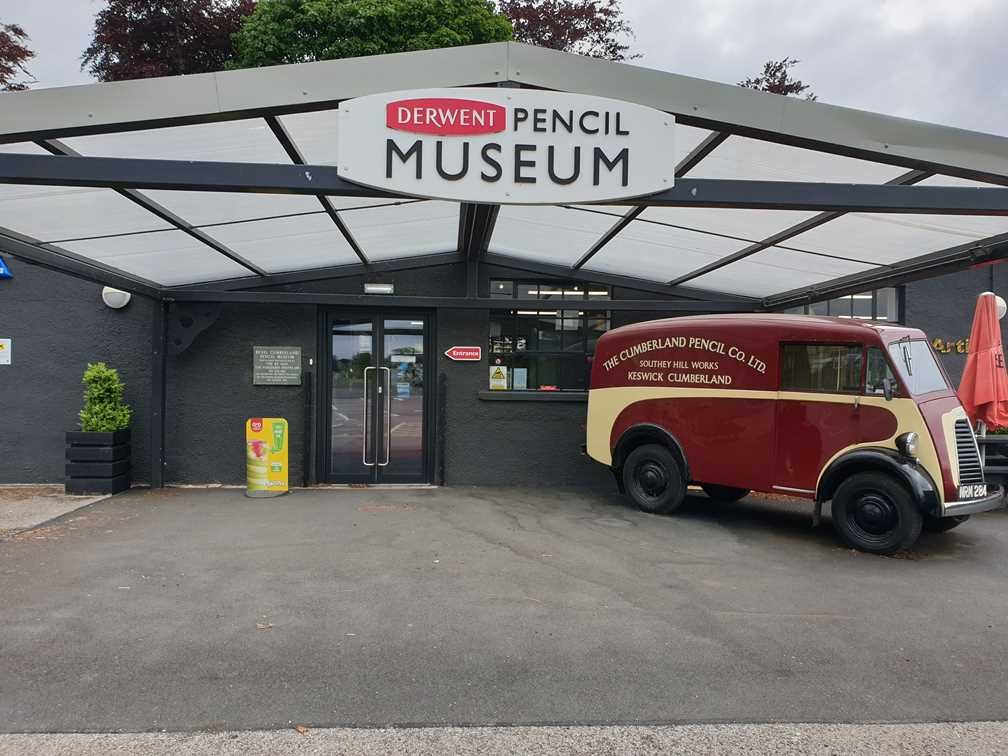
Nestled charmingly at the foot of the imposing Skiddaw mountain, and conveniently positioned between the shimmering waters of Derwentwater and Bassenthwaite Lake, lies a truly unexpected and utterly delightful attraction: the Keswick Pencil Museum. Far from being a dry historical account, this quirky institution tells a fascinating story of ingenuity, industry, and the surprising global impact sparked by a rare local resource.
The museum celebrates the extraordinary journey of graphite, first discovered in the Seathwaite Valley in the 16th century, and how this unique geological quirk of Cumbria ignited a world-leading pencil manufacturing industry right here in Keswick. It meticulously traces the evolution of the pencil from its humble beginnings as a simple stick of graphite wrapped in string to the sophisticated writing implement we know today.
Among its many captivating exhibits, visitors can marvel at the world’s largest pencil, a truly monumental testament to the craft, stretching an impressive 26 feet in length and weighing in at nearly half a ton. But the museum’s appeal extends beyond mere size. It delves into the surprising and often whimsical applications of pencils throughout history, including their vital role in espionage during World War II, where pencils concealed miniature compasses and maps for Allied spies. These fascinating relics offer a unique glimpse into a hidden side of wartime history, blending education with a touch of thrilling intrigue.
The Keswick Pencil Museum is more than just a collection of historical artefacts; it’s a testament to how Cumbria’s distinctive geological makeup has profoundly shaped its economic landscape and creative identity. It’s a place where industrial heritage meets artistic flair, underscoring the innovative spirit that has long characterised the region. For families, history enthusiasts, or anyone seeking a surprisingly engaging and educational experience off the beaten path, the quirky Keswick Pencil Museum offers a truly inspiring insight into the humble yet mighty pencil and its deep roots in the Cumbrian landscape.
Soar Above Cumbria in a Hot Air Balloon
For an unparalleled perspective on Cumbria’s breathtaking and diverse landscape, there’s no experience quite like soaring silently above it in a hot air balloon. Rising gently from various launch sites, often located in the picturesque Eden Valley or on the serene margins of the Lake District National Park, these flights offer a truly panoramic spectacle.
As you ascend, a vibrant patchwork unfolds beneath you: the shimmering expanses of iconic lakes like Windermere and Ullswater, the dramatic contours of ancient mountains, the tranquil beauty of marshes and wetlands, and the meticulously patterned fields of Cumbrian farmland. The view stretches far beyond the immediate fells, encompassing the majestic Pennine Hills to the east, their rugged peaks forming a distant, undulating spine, and to the west, the glittering expanse of the Solway Firth and its unique saltmarshes, where land meets sea in a constantly shifting embrace. At the very heart of this vast panorama lie the volcanic fells, the dramatic crags and summits that define the Lake District, testament to millions of years of geological upheaval.
This sky-high journey isn’t just a scenic tour; it’s an opportunity to trace the region’s ancient geological stories laid bare. From your unique vantage point, you can discern the immense forces that shaped this land – the colossal power of glaciers carving out the U-shaped valleys now cradling the lakes, the ancient volcanic eruptions that formed the jagged peaks, and the subsequent deposition of various rock types that create the distinct character of each area. It’s as if the entire county transforms into a vast, open-air museum, revealing its deep history to adventurous spirits willing to embrace the silence and majesty of the skies.
A hot air balloon flight over Cumbria is a truly unforgettable experience, offering not only breathtaking photographic opportunities but also a profound sense of peace and wonder as you drift with the wind, absorbing the sheer scale and beauty of this remarkable corner of England. It’s a moment of serene exhilaration, providing a fresh and entirely unique appreciation for the diverse landscapes and ancient stories etched into the very fabric of Cumbria.
Unique Outdoor Experiences Cumbria: Unwind in an Outdoor Jacuzzi with Mountain Views
One of Cumbria’s most indulgent and unique ways to connect with its magnificent landscape is by unwinding in an outdoor jacuzzi with panoramic mountain views. Many luxury spas and hotels across the Lake District, particularly in sought-after locations like Ullswater, Windermere, and Grasmere, now feature these exquisite outdoor hot tubs, strategically nestled in prime positions.
Imagine sinking into steaming, therapeutic waters as you gaze out over a landscape of unparalleled beauty. You’re surrounded by the majestic fells, their ancient forms sculpted over millions of years by the immense power of volcanoes and the relentless march of glaciers. These are the very mountains that define the Lake District – with iconic peaks like the imposing Blencathra to the north, its distinctive profile etched against the sky, or the rugged beauty of the Coniston Fells, testament to the region’s dramatic geological past.
This experience transcends mere relaxation; it’s an oddly elemental and profoundly immersive way to connect with the land. The warmth of the water contrasts with the crisp Cumbrian air, and the sheer scale of the natural surroundings fosters a sense of awe and tranquillity. Whether bathed in the golden light of dawn, silhouetted against a vibrant sunset, or under a canopy of twinkling stars, the views from these outdoor jacuzzis offer an ever-changing masterpiece.
Beyond the well-known spa towns, you’ll find similar opportunities at more secluded retreats and even some luxurious self-catering lodges, often positioned to maximise their spectacular vistas over valleys, tranquil tarns, or sweeping lake views. It’s an ideal way to soothe tired muscles after a day of exploring the fells, or simply to bask in the serene beauty of the Lake District, providing a luxurious yet deeply authentic encounter with Cumbria’s wild heart.
Ride the La’al Ratty Miniature Steam Railway
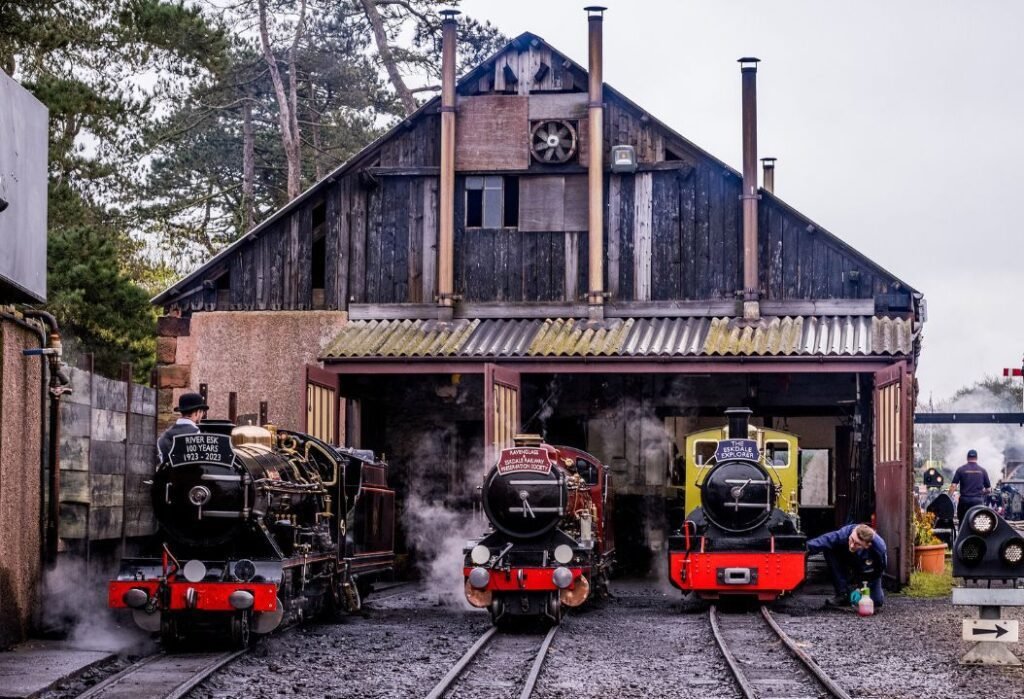
Embark on a charming and historic journey aboard the Ravenglass & Eskdale Railway, affectionately known by its Cumbrian dialect name, the “La’al Ratty” (meaning ‘little railway’). This delightful narrow-gauge steam railway offers a unique and nostalgic adventure, winding its way from the picturesque coastal village of Ravenglass, the Lake District’s only coastal village, deep into the heart of the region’s dramatic western fells.
The railway’s route traces the course of the meandering River Esk, leading passengers through a landscape of unparalleled natural beauty. As the miniature steam locomotive puffs its way inland, you’ll pass through ancient oak woods, where dappled sunlight filters through the canopy, and catch glimpses of sparkling waterfalls tumbling down the hillsides. The scenery gradually transitions to open uplands and vast expanses of bracken-covered hills, revealing the rugged grandeur that defines this less-explored corner of Cumbria.
More than just a scenic ride, the La’al Ratty offers a tangible link to the area’s rich industrial past. This narrow-gauge line, originally built in 1875, played a crucial role in transporting iron ore from the mines in the Eskdale valley to the main line at Ravenglass. The journey today highlights how history and geography are profoundly intertwined on Cumbria’s wild western frontier. You’ll pass historic quarries, old miners’ paths, and remnants of a bygone era, all set against the breathtaking backdrop of the volcanic fells, including the towering presence of Scafell Pike, England’s highest mountain.
The charm of the La’al Ratty lies not only in its stunning views but also in its meticulously preserved steam engines and heritage carriages, evoking a sense of stepping back in time. It’s a perfect outing for families, railway enthusiasts, or anyone seeking a peaceful and immersive way to experience the unique blend of coastal charm, industrial heritage, and raw natural beauty that defines this distinctive part of Cumbria.
Conclusion: Discover the Unexpected in Cumbria’s Remarkable Landscape
Cumbria, at first glance, might seem to present a familiar tableau of postcard-perfect lakes and well-trodden hiking trails. Indeed, its natural grandeur is undeniable and rightly celebrated. However, as this guide has aimed to reveal, the county truly rewards the curious and the adventurous with a wealth of experiences as diverse and captivating as its very terrain.
Beyond the iconic vistas, Cumbria invites you to delve deeper, to uncover stories and activities that are profoundly shaped by its dramatic geology and vibrant cultural history. Whether you’re channelling your inner warrior by throwing axes amidst ancient parkland, sending shivers down your spine during a ghost hunt within the storied walls of Muncaster Castle, or gracefully ballooning high above valleys carved by colossal glaciers, each unusual experience offers a fresh and often surprising perspective. These activities are not mere novelties; they are intimately connected to the very fabric of Cumbria, mirroring the forces that sculpted its mountains, the industries that sprang from its earth, and the folklore woven into its communities.
From the visible remnants of a submerged village revealing a poignant human story, to the serene contemplation offered by a Buddhist retreat overlooking tidal estuaries, and the quirky charm of a museum celebrating the humble pencil born from local graphite, Cumbria demonstrates that the extraordinary is never out of place. Instead, it is an integral part of what makes this landscape so endlessly fascinating for those willing to scratch beneath the surface and explore. So, step off the beaten path, embrace the unconventional, and discover the hidden depths and unexpected delights that truly define Cumbria’s remarkable and multifaceted character.
Frequently Asked Questions: Unusual Things to Do in Cumbria
What are some unique or quirky attractions in Cumbria?
Cumbria is full of surprises! Alongside the famous lakes, you can explore sunken villages, haunted castles, walk with alpacas, try axe throwing, visit the world’s oldest pencil factory, or ride the La’al Ratty miniature steam railway through dramatic mountain scenery.
Are these unusual experiences suitable for families?
Most are family-friendly, alpaca walks, miniature train rides, and the pencil museum are great for all ages. Experiences like ghost tours may be better for older kids and adults seeking a thrill.
Do I need to book activities like hot air balloon rides or spa jacuzzis in advance?
Yes, for experiences such as balloon flights or outdoor jacuzzis at local spas, it’s recommended to book ahead, especially in peak holiday seasons.
Is transport to remote places like the Merzbarn or Eskdale Valley easy without a car?
Some rural sites are best reached by car, but you can also use local buses, heritage trains, or guided tours to access popular locations.
Can I do these activities year-round?
Most attractions are open all year, but activities like hot air ballooning or ghost tours may depend on the weather or season. Always check ahead with operators for opening times.
Are these unusual experiences weather-dependent?
Outdoor adventures, balloon rides, alpaca walks, and some ghost hunts can be affected by the famously changeable Cumbrian weather. Indoor options like museums or art barns are good backup plans.
